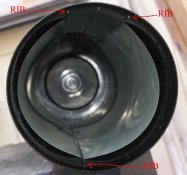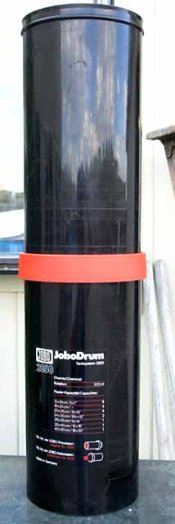clay said:
Sandy,
The hot streaks would not happen every time. Maybe one out of twenty negs. But I could never predict it, other than to know it would happen when I could least afford it.
The culprit seems to be the concentric ribs on the interior of the drum instead of the longitudinal ribs. I would get changes in the amount of stain right around the rib. It can be very subtle. In fact I have a few negatives that show no unevenness to the naked eye, but you sure as hell can see the streak when you print them in platinum. Some of the other problems I had I eventually corrected through some technique changes. One was to use quite a bit of volume to minimize oxidation effects. I typically would use 1000ml for 2 7x17 sheets in the drums. I also used a 2:1:100 or 2:1:150 dilution for pyrocat, which also would help minimize any runaway base + fog problems.
Clay,
Many years ago ((early 90s?) when people first started experimenting with rotary type processing with staining developers of ULF film, including Jobo and film drums, there were numerous reports of development artifacts, ranging from streak patterns on the film that corresponded to the direction of rotation to stains that seemed to correspond to the ribs of the drums. I also heard reports of lines such as the one you describe that were not visible to the eye but would definitely show up on the print with UV processes. Quite a number of people concluded from these experiences that rotary processing was not worth the problem and returned to tray.
However, as I have stated many times, standing there in the dark for long periods processing film is not something I like to do so spent a lot of time thinking about my own technique and examing the results. I don't pretend to have all of the answers but here are some of my thoughts on the way to get very even development with rotary processing. Some of the things I see you do already so I suspect that the difference in our results is equipment, not technique.
1. Use a fairly large amount of developer solution as this minimizes the effects of developer speed up when crossing over any dividers that may be in drum. For example, I use 2 liters of solution per sheet of 12X20 film, quite a bit more than necessary (about 4X as much in fact).
2. Rotation should be as slow as your equipment will allow, down to 5 RPM if possible. Fast rotation is very risky, not only because it increases oxidation that gives higher general stain but also because it can create hot spots.
3. Rotation should be in both directions so it is important to use a motor base that reverses direction.
4. Lift the drum or tube off the motor base frequently and give the film vigorous sideways agitation. It is very important to start this pattern of agitation very early in the cycle, say within 15 seconds or so of the beginning of development, because any patterns of unevenness always start during the first seconds of development and increase with time. Anything you can do to inrtroduce a random pattern to development is useful in breaking up laminar flow patterns that can cause hot spots.
5. If you are using Pyrocat-HD increase the proportion of Solution A to B in the developer, and use a fairly weak dilution. I personally use a 1.5:1:100 but I can see that 2:1:150 might actually work better (more developer exhaustion and edge effects but less oxidation).
Regarding those lines on the film that are not visible to the eye but show up during printing I have also seen this, but in my case I concluded that this was due to coating irregularities of the film during manufacture, not development technique.
I have also concluded, for my own conditions, that the ribs that run lengthwise in print drums do not create any development artifacts, so long as 1) the film is pre-soaked, 2) speed of rotation is kept to 5 RPM or less, 3) a large amount of total solution is used, and 4) a fairly weak dilution of developer is used, with more Solution A than B.
In spite of my very positive experiences with rotary processing I would encourage others to actually test how even your film is developed by sacrificing a few sheets of film by exposing them to an even light source and then developing with several techniques, say in a tray, in a tube or drum on a motor base, or in a tube that is used in a water bath as with BTZS type tubes. I know from my own tests that I get the most even development in the following order: best in smooth walled tubes in a water bath, after an initial pre-soak, second best in drums on a motor base, and last in tray development. Which convinces me that the key to even develpment is slow but continuous random agitation. From my tests I would conclude that the best method for 7X17 film would be the use of BTZS type tubes (which one could easily make from ABS plastic), with agitation by rolling them in a water bath. But there are some practical considerations which make the use of tubes of this size much more difficult than in smaller sizes such as 4X5 and 5X7.
But I have to admit than even if the order of even development was reversed I would still use the drums because of my dislike for working in the dark.
Sandy













